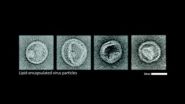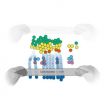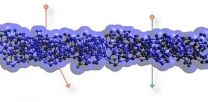(Press-News.org) In the quest to make sun power more competitive, researchers are designing ultrathin solar cells that cut material costs. At the same time they're keeping these thin cells efficient by sculpting their surfaces with photovoltaic nanostructures that behave like a molecular hall of mirrors.
"We want to make sure light spends more quality time inside a solar cell," said Mark Brongersma, a professor of materials science and engineering at Stanford and co-author of a review article in Nature Materials.
Brongersma and two Stanford colleagues -- associate professor of materials science and engineering Yi Cui and professor of electrical engineering Shanhui Fan -- surveyed 109 recent scientific papers from teams around the world.
Their overview revolves around a basic theme: looking at the many different ways that researchers are trying to maximize the collisions between photons and electrons in the thinnest possible layers of photovoltaic materials. The goal is to reveal trends and best practices that will help drive developments in the field.
Solar energy is produced when photons of light collide with the electrons in a photovoltaic crystal. As loose electrons move through the crystal, they generate an electrical current.
Today's solar cells are already thin. They are made up of layers of photovoltaic materials, generally silicon, that average 150 to 300 micrometers, which is roughly the diameter of two to three human hairs.
As engineers continue to shave down those dimensions they have to develop new molecular traps and snares to ensure that photons don't simply whiz through their ultrathin solar cells before the electrical sparks can fly.
"A lot of the excitement now is about using the principles of photonics to manage light waves in the most efficient way," Fan said. "There are perhaps hundreds of groups in the world working on this."
The review article provides a high level view of how scientists are trying to design structures to facilitate interactions between the infinitesimal instigators of solar current, the photons and the electrons.
Research face enormous challenges in trying to architect nanostructures attuned to catch light. Sunlight consists of many colors. When we see rainbow, what we see is result of atmospheric moisture acting as a prism to bend light into its constituent colors. Creating different nanostructures to catch the pot of photons at the end of each color of the rainbow is part of what this research is about.
Nevertheless, scientists are already reporting some success
"We are seeing systems that use one one-hundredth as much photovoltaic material as today's solar cells while getting 60 percent to 70 percent of the electrical output," Brongersma said.
The most common photovoltaic material is a refined form of silicon similar to that found in computer chips. This material accounts for 10 percent to 20 percent of a solar cell's cost. Lowering those expenses 100-fold would therefore have a considerable effect on the overall cost-efficiency of solar energy production.
But Cui says lowering material costs is only part of the push behind ultrathin solar. Another benefit is flexibility. Because of the thickness of the light-catching silicon layer, today's solar cells must be kept rigid lest their crystal lattice be damaged and the flow of electrons disrupted.
"But at 10 micrometers of thickness silicon has a high degree of mechanical flexibility," said Cui, citing a dimension less than one-tenth the thickness of the photovoltaic layer inside today's solar cells.
Cui, who has made just such an experimental material, shows a movie of flapping this thin silicon like a piece of paper and cutting it with a scissors (see separate videos; flapping http://www.youtube.com/watch?v=e71Z0Kt3bsQ and cutting http://www.youtube.com/watch?v=PFyKfkwPRfs). Those thin silicon strips incorporate some of the photon-trapping nanostructures described in the Nature Materials article. Cui says the light-to-energy conversion efficiency of thin silicon is approaching that of the rigid silicon in today's solar cells.
Flapping silicon isn't just a science project. Such flexibility would pay a dividend when it comes to installation, which accounts for roughly one-third of the total cost of a rooftop solar array. "These thin silicon cells can be embedded into flexible plastic, making installation like rolling out a carpet," Cui said.
Yet even as researchers succeed in getting more from less, many hurdles remain according to Fan, who develops computer models to study how different nanostructures and materials will affect photon-electron interactions.
"There are an infinite number of structures, so it isn't possible to model them all," he said, alluding to what he called the "theoretical bottlenecks" that impede scientific understanding of this ethereal realm where light and matter intersect.
"For instance, right now, we really don't have a way to know when we've gotten the most out of our photons," Fan said.
INFORMATION:
Tom Abate is Associate Director of Communications at Stanford Engineering
Like a hall of mirrors, nanostructures trap photons inside ultrathin solar cells
2014-04-22
ELSE PRESS RELEASES FROM THIS DATE:
Grasp of SQUIDs dynamics facilitates eavesdropping
2014-04-22
Theoretical physicists are currently exploring the dynamics of a very unusual kind of device called a SQUID. This Superconducting Quantum Interference Device is a highly sensitive magnetometer used to measure extremely subtle magnetic fields. It is made of two thin regions of insulating material that separate two superconductors – referred to as Josephson junctions – placed in parallel into a ring of superconducting material. In a study published in EPJ B, US scientists have focused on finding an analytical approximation to the theoretical equations that govern the dynamics ...
Cloaked DNA nanodevices survive pilot mission
2014-04-22
VIDEO:
Wyss Institute Core Faculty member William Shih and Technology Development Fellow Steven Perrault explain why DNA nanodevices need protection inside the body and how a virus-inspired strategy helps protect them....
Click here for more information.
It's a familiar trope in science fiction: In enemy territory, activate your cloaking device. And real-world viruses use similar tactics to make themselves invisible to the immune system. Now scientists at Harvard's Wyss Institute ...
Carnegie Mellon system lets iPad users explore data with their fingers
2014-04-22
PITTSBURGH—Spreadsheets may have been the original killer app for personal computers, but data tables don't play to the strengths of multi-touch devices such as tablets. So researchers at Carnegie Mellon University have developed a visualization approach that allows people to explore complex data with their fingers.
Called Kinetica, this proof-of-concept system for the Apple iPad converts tabular data, such as Excel spreadsheets, so that data points appear as colored spheres on the touchscreen. People can directly manipulate this data, using natural gestures to sort, ...
Child's autism risk accelerates with mother's age over 30
2014-04-22
PHILADELPHIA (April 22, 2014) – Older parents are more likely to have a child who develops an autism spectrum disorder (ASD) than are younger parents. A recent study from researchers from the Drexel University School of Public Health in Philadelphia and Karolinska Institute in Sweden provides more insight into how the risk associated with parental age varies between mothers' and fathers' ages, and found that the risk of having a child with both ASD and intellectual disability is larger for older parents.
In the study, published in the February 2014 issue of the International ...
Nanomaterial outsmarts ions
2014-04-22
Ions are an essential tool in chip manufacturing, but these electrically charged atoms can also be used to produce nano-sieves with homogeneously distributed pores. A particularly large number of electrons, however, must be removed from the atoms for this purpose. Such highly charged ions either lose a surprisingly large amount of energy or almost no energy at all as they pass through a membrane that measures merely one nanometer in thickness. Researchers from the Helmholtz-Zentrum Dresden-Rossendorf (HZDR) and Vienna University of Technology (TU Wien) report in the scientific ...
Gym culture likened to McDonalds
2014-04-22
Visit a typical gym and you will encounter a highly standardised notion of what the human body should look like and how much it should weigh. This strictly controlled body ideal is spread across the world by large actors in the fitness industry.
A new study explores how the fitness industry in many ways resembles that of fast food. One of the authors is from the University of Gothenburg.
McDonaldisation of the gym culture is the theme of an article published in Sports, Education and Society, where Thomas Johansson, professor at the University of Gothenburg, together ...
Two genes linked to inflammatory bowel disease
2014-04-22
CINCINNATI—Inflammatory Bowel Disease (IBD), a group of chronic inflammatory disorders of the intestine that result in painful and debilitating complications, affects over 1.4 million people in the U.S., and while there are treatments to reduce inflammation for patients, there is no cure.
Now, Cincinnati Cancer Center and University of Cincinnati (UC) Cancer Institute researcher Susan Waltz, PhD, and scientists in her lab have done what is believed to be the first direct genetic study to document the important function for the Ron receptor, a cell surface protein often ...
New design for mobile phone masts could cut carbon emissions
2014-04-22
A breakthrough in the design of signal amplifiers for mobile phone masts could deliver a massive 200MW cut in the load on UK power stations, reducing CO2 emissions by around 0.5 million tonnes a year.
Funded by the Engineering and Physical Sciences Research Council (EPSRC), the Universities of Bristol and Cardiff have designed an amplifier that works at 50 per cent efficiency compared with the 30 per cent now typically achieved.
Currently, a 40W transmitter in a phone mast's base station* requires just over 130W of power to amplify signals and send them wirelessly ...
Speed-reading apps may impair reading comprehension by limiting ability to backtrack
2014-04-22
To address the fact that many of us are on the go and pressed for time, app developers have devised speed-reading software that eliminates the time we supposedly waste by moving our eyes as we read. But don't throw away your books, papers, and e-readers just yet — research suggests that the eye movements we make during reading actually play a critical role in our ability to understand what we've just read.
The research is published in Psychological Science, a journal of the Association for Psychological Science.
"Our findings show that eye movements are a crucial part ...
UV-radiation data to help ecological research
2014-04-22
Many research projects study the effects of temperature and precipitation on the global distribution of plant and animal species. However, an important component of climate research, the UV-B radiation, is often neglected. The landscape ecologists from UFZ in collaboration with their colleagues from the Universities in Olomouc (Czechia), Halle and Lüneburg have processed UV-B data from the U.S. NASA space agency in such a way that they can be used to study the influence of UV-B radiation on organisms.
The basic input data were provided by a NASA satellite that regularly, ...





